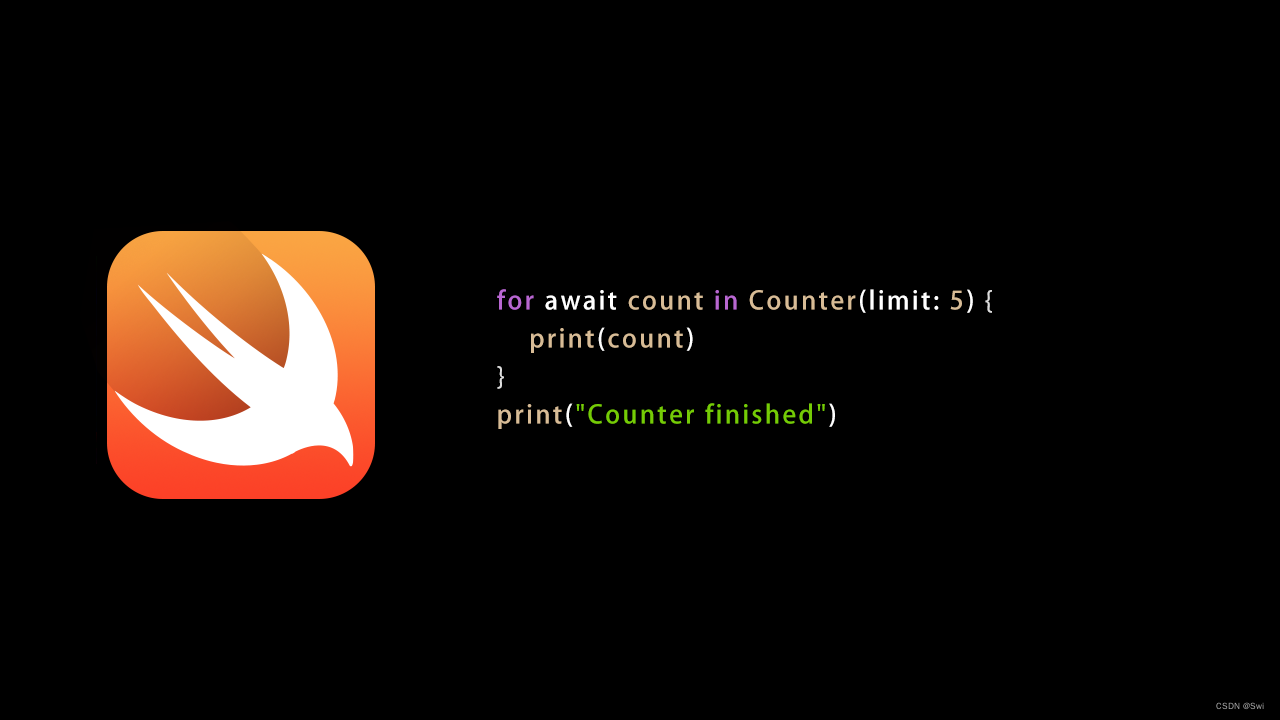文章目录 前言什么是 AsyncSequence?创建 AsyncSequence异步序列的迭代结论 前言 AsyncSequence 是并发性框架和 SE-298 提案的一部分。它的名字意味着它是一个提供异步、顺序和迭代访
AsyncSequence 是并发性框架和 SE-298 提案的一部分。它的名字意味着它是一个提供异步、顺序和迭代访问其元素的类型。换句话说:它是我们在 Swift 中熟悉的常规序列的一个异步变体。
就像你不会经常创建你的自定义序列一样,我不期望你经常创建一个自定义的 AsyncSequence 实现。然而,由于与 AsyncThrowingStream和AsyncStream 等类型一起使用,你很可能不得不与异步序列一起工作。因此,我将指导你使用 AsyncSequence 实例进行工作。

AsyncSequence 是我们在Swift中熟悉的 Sequence 的一个异步变体。由于它的异步性,我们需要使用 await 关键字,因为我们要处理的是异步定义的方法。如果你没有使用过 async/await,我鼓励你阅读我的文章:Swift 中的async/await ——代码实例详解
值可以随着时间的推移而变得可用,这意味着一个 AsyncSequence 在你第一次使用它时可能不包含也可能包含一些,或者全部的值。
重要的是要理解 AsyncSequence 只是一个协议。它定义了如何访问值,但并不产生或包含值。AsyncSequence 协议的实现者提供了一个 AsyncIterator,并负责开发和潜在地存储值。
| Function | Note |
|---|---|
contains(_ value: Element) async rethrows -> Bool | Requires Equatable element |
contains(where: (Element) async throws -> Bool) async rethrows -> Bool | The async on the closure allows optional async behavior, but does not require it |
allSatisfy(_ predicate: (Element) async throws -> Bool) async rethrows -> Bool | |
first(where: (Element) async throws -> Bool) async rethrows -> Element? | |
min() async rethrows -> Element? | Requires Comparable element |
min(by: (Element, Element) async throws -> Bool) async rethrows -> Element? | |
max() async rethrows -> Element? | Requires Comparable element |
max(by: (Element, Element) async throws -> Bool) async rethrows -> Element? | |
reduce | |
reduce |
对于这些函数,我们首先定义一个符合 AsyncSequence 协议的类型。该名称是模仿现有的标准库“序列”类型,如 LazyDropWhileCollection 和LazyMapSequence 。然后,我们在 AsyncSequence 的扩展中添加一个函数,该函数创建新类型(使用’ self ‘作为’ upstream ')并返回它。
| Function |
|---|
map |
compactMap |
flatMap |
drop(while: (Element) async throws -> Bool) async rethrows -> AsyncDropWhileSequence |
dropFirst(_ n: Int) async rethrows -> AsyncDropFirstSequence |
prefix(while: (Element) async throws -> Bool) async rethrows -> AsyncPrefixWhileSequence |
prefix(_ n: Int) async rethrows -> AsyncPrefixSequence |
filter(_ predicate: (Element) async throws -> Bool) async rethrows -> AsyncFilterSequence |
创建一个自定义的 AsyncSequence。
为了更好地理解 AsyncSequence 是如何工作的,我将演示一个实现实例。然而,在定义你的 AsyncSequence 的自定义实现时,你可能想用 AsyncStream 来代替,因为它的设置更方便。因此,这只是一个代码例子,以更好地理解 AsyncSequence 的工作原理。
下面的例子沿用了原始提案中的例子,实现了一个计数器。这些值可以立即使用,所以对异步序列没有太大的需求。然而,它确实展示了一个异步序列的基本结构:
struct Counter: AsyncSequence { typealias Element = Int let limit: Int struct AsyncIterator : AsyncIteratorProtocol { let limit: Int var current = 1 mutating func next() async -> Int? { guard !Task.isCancelled else { return nil } guard current <= limit else { return nil } let result = current current += 1 return result } } func makeAsyncIterator() -> AsyncIterator { return AsyncIterator(howHigh: limit) }}如您所见,我们定义了一个实现 AsyncSequence 协议的 Counter 结构体。该协议要求我们返回一个自定义的 AsyncIterator,我们使用内部类型解决了这个问题。我们可以决定重写此示例以消除对内部类型的需求:
struct Counter: AsyncSequence, AsyncIteratorProtocol { typealias Element = Int let limit: Int var current = 1 mutating func next() async -> Int? { guard !Task.isCancelled else { return nil } guard current <= limit else { return nil } let result = current current += 1 return result } func makeAsyncIterator() -> Counter { self }}我们现在可以将 self 作为迭代器返回,并保持所有逻辑的集中。
注意,我们必须通过提供 typealias 来帮助编译器遵守 AsyncSequence 协议。
next() 方法负责对整体数值进行迭代。我们的例子归结为提供尽可能多的计数值,直到我们达到极限。我们通过对 Task.isCancelled 的检查来实现取消支持。

现在我们知道了什么是 AsyncSequence 以及它是如何实现的,现在是时候开始迭代这些值了。
以上述例子为例,我们可以使用 Counter 开始迭代:
for await count in Counter(limit: 5) { print(count)}print("Counter finished")// Prints:// 1// 2// 3// 4// 5// Counter finished我们必须使用 await 关键字,因为我们可能会异步接收数值。一旦不再有预期的值,我们就退出for循环。异步序列的实现者可以通过在 next() 方法中返回 nil 来表示达到极限。在我们的例子中,一旦计数器达到配置的极限,或者迭代取消,我们就会达到这个预期:
mutating func next() async -> Int? { guard !Task.isCancelled else { return nil } guard current <= limit else { return nil } let result = current current += 1 return result}许多常规的序列操作符也可用于异步序列。其结果是,我们可以以异步的方式执行映射和过滤等操作。
例如,我们可以只对偶数进行过滤:
for await count in Counter(limit: 5).filter({ $0 % 2 == 0 }) { print(count)}print("Counter finished")// Prints: // 2// 4// Counter finished或者我们可以在迭代之前将计数映射为一个 String :
let counterStream = Counter(limit: 5) .map { $0 % 2 == 0 ? "Even" : "Odd" }for await count in counterStream { print(count)}print("Counter finished")// Prints:// Odd// Even// Odd// Even// Odd// Counter finished我们甚至可以使用 AsyncSequence 而不使用for循环,通过使用 contains 等方法。
let contains = await Counter(limit: 5).contains(3)print(contains) // Prints: true注意,上述方法是异步的,意味着它有可能无休止地等待一个值的存在,直到底层的 AsyncSequence 完成。
AsyncSequence 是我们在Swift中熟悉的常规 Sequence 的异步替代品。就像你不会经常自己创建一个自定义 Sequence 一样,你也不太可能创建自定义的异步序列。
来源地址:https://blog.csdn.net/qq_36478920/article/details/130521833
--结束END--
本文标题: Swift AsyncSequence — 代码实例详解
本文链接: https://lsjlt.com/news/371936.html(转载时请注明来源链接)
有问题或投稿请发送至: 邮箱/279061341@qq.com QQ/279061341
2024-05-24
2024-05-24
2024-05-24
2024-05-24
2024-05-24
2024-05-24
2024-05-24
2024-05-24
2024-05-24
2024-05-24
回答
回答
回答
回答
回答
回答
回答
回答
回答
回答
0